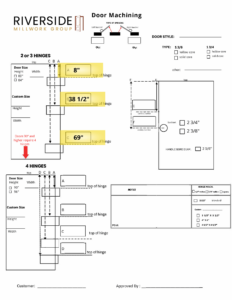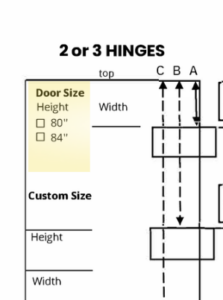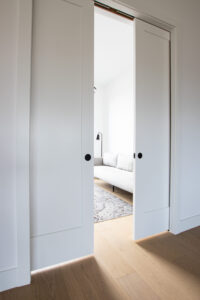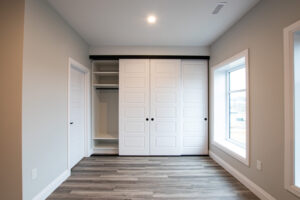(Rewrite: Apr 2025)
Interior Doors
If you’re currently looking at your late 80’s or early 90’s builder-grade doors and thinking “these just aren’t cutting it anymore”… you’re not alone!
Today’s builder-grade interiors have come a long way. Whether it’s for aesthetic reasons or functionality, many homeowners are opting to upgrade their interior doors to something more modern, more solid, or more stylish. When it comes to replacing interior doors, there are two main routes you can take: a door retrofit or a full frame replacement.
In this blog, we’ll walk you through six key factors to help you decide whether retrofitting is the right solution for your home, how to measure accurately, and what the retrofit process looks like for different types of doors.
What Is a Door Retrofit?
A door retrofit is when you replace just the door slab and reuse the existing door frame (jamb), hinges, and casing. It’s a great solution if your door frames are in good condition, and you want to keep your trim intact. The result is a fresh, upgraded door without the added cost or labour of tearing out the existing frame and finishing around it.
At Riverside Millwork Group, we help customers retrofit their doors with precision using our Door Machining Sheet — a tool that ensures every measurement is accounted for so the new door fits seamlessly into the old frame.
6 Factors to Consider Before Retrofitting Your Doors
Are Your Door Frames Square?
The first thing to check is whether your door frames are level and square. A new door slab is perfectly straight, so if your frame is warped or bowed, the door may not close properly.
To test this, use a level or measuring tape to assess the top and sides of your door frame. If everything lines up and is structurally sound, you’re a good candidate for a door retrofit. If not, it may be time to consider a full frame replacement.
What Size Are Your Current Doors?
Most interior doors fall into standard sizes. At Riverside Millwork Group, we commonly see:
- Ready-Made Doors: 30” wide by 80” tall
- Stile & Rail Doors (custom built in our mill): 30” wide by 90–96” tall, ultimately custom is just that, custom, so there are many possibilities.
If your current doors are standard size, retrofitting is usually straightforward. However, if your doors are an unusual size or were custom-made for your home, you may not be able to retrofit without reframing.
Custom sizes can still be accommodated, but they often require more specialized work and longer lead times.
Are the Current Doors Beveled?
Beveling refers to the slight angle on the leading edge of a door, designed to help it close smoothly into the jamb. Most interior doors have a 1 to 2-degree bevel on the latch side.
If your current doors are beveled, your replacements should be too — especially for a clean retrofit. This helps prevent rubbing, sticking, or gaps. At Riverside, we offer this beveling as part of our door machining service to ensure the perfect fit.
Do the Hinge and Lockset Locations Match?
Matching the hinge locations and lockset bore is essential in any door retrofit. Here’s how we recommend measuring:
- Hinge Positions: Measure from the top of the door to the top of each hinge. Most 80” doors have either two or three hinges, while taller doors (84” or higher) may require four.
- Lockset Location: Measure from the top of the door to the center of the lock hole. Then measure the backset, which is the distance from the door’s edge to the center of the lock hole — typically 2 ⅜” or 2 ¾”.
These measurements are then transferred onto our Door Machining Sheet, which we use to create a pre-machined door that aligns perfectly with your existing frame.
What Is the Door Thickness?
Interior doors generally come in two standard thicknesses:
- 1 ⅜”
- 1 ¾”
It’s important to match the new door thickness with your current door to avoid problems with the hinges, strike plate, and doorstop. If you’re changing door thickness, you’ll likely need to adjust the jamb, which may make retrofitting more complicated.
What’s the Condition of the Casing?
The casing is the trim that frames your door. If your casing is in good shape and you’re happy with its appearance, retrofitting is a great way to preserve it while upgrading your doors.
But if your trim is damaged, outdated, or doesn’t match the new doors you’ve selected, it may be worth removing everything and starting fresh with a new frame and casing that complements your updated interior.
How to Measure for a Retrofit Door
Here’s a quick step-by-step guide based on our Retrofit Door Video:
- Determine the Door Swing (Handing):
- Stand on the side of the door where it opens away from you.
- If the hinges are on the right, it’s a right-hand swing. If they’re on the left, it’s a left-hand swing.

- Measure Hinge Locations (from top of the door):
- Top Hinge (Position A): e.g. 8”
- Middle Hinge (Position B): e.g. 38 ½”
- Bottom Hinge (Position C): e.g. 69”

- Measure the Lockset:
- From the top of the door to the center of the lockset (e.g. 44”).
- Measure the backset: from the edge of the door to the center of the lock hole (typically 2 ⅜” or 2 ¾”).

- Measure the Door Itself:
- Height (edge to edge)
- Width (edge to edge)

- Fill out the Door Machining Sheet:
- Indicate if it’s a hollow or solid core
- Select door style
- Thickness

Once complete, submit your sheet to our team and we’ll take care of the rest.
For more detailed instruction on how to fill out our Door Machining sheet please click here to see our step-by-step video.
Retrofitting Different Types of Doors
Many customers search for specific guidance on how to retrofit various types of doors. Here’s what you need to know depending on the door type:
Retrofitting a Pocket Door
Retrofit pocket doors are tricky because the track is hidden inside the wall.

- If the frame and track are in good condition, you can replace just the slab.
- You must ensure precise door sizing and machining to align with the existing rollers.
- Replacing a damaged track typically means opening up the wall — at which point, you may want to consider a full replacement.
We can machine pocket doors at our mill to suit your current hardware if it’s still functioning well.
Retrofitting an Exterior Door
Retrofit exterior doors involve more than just matching sizes — they need to be weather-tight, secure, and energy efficient.

- If you’re only replacing the slab, you must ensure a tight fit, proper beveling, and weatherproofing.
- Matching the threshold, lockset, and hinges is crucial.
- Most homeowners choose to replace the entire exterior door unit — slab, frame, and weatherstripping — for the best performance.
Retrofitting a Sliding Door
Retrofit sliding doors may involve replacing just the panels or the full track system.

- If your frame and track are still functional, you can install new sliding panels to refresh the look.
- Make sure to match the panel size and hardware system precisely.
- For better energy efficiency and operation, full replacement may be the better option.
Still Not Sure? We’re Here to Help
Retrofitting doors is an efficient and cost-effective way to upgrade your space — as long as the existing frame and casing are in good condition.
At Riverside Millwork Group, we make retrofitting easy with:
- Door Machining Sheets to ensure precision
- Step-by-step retro fit door video for easier for more comprehensive instruction
- Experienced team members who walk you through the process
- Custom door styles and sizes made right in our local mill
